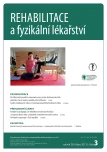Influence of the Träbert current on the autonomic nervous system, evaluated by parameters of time and spectral analysis of heart rate variability in healthy probands
Authors:
Uhlíř P.
Authors‘ workplace:
Katedra fyzioterapie, Fakulta tělesné kultury, Univerzita Palackého v Olomouci
Published in:
Rehabil. fyz. Lék., 28, 2021, No. 3, pp. 104-108.
Category:
Original Papers
doi:
https://doi.org/10.48095/ccrhfl2021104
Overview
This article focuses on the evaluation of the Träbert current on the autonomic nervous system by parameters of heart rate variability in healthy probands. In this study, a statistically significant increase of the indices of spectral analysis of heart rate variability in frequency domain (Power HF) and time domain (RR intervals, mean square succesive differences) after application of the Träbert current (increase of vagal activity) were found.
Keywords:
autonomic nervous system – heart rate variability – spectral analysis – Träbert current
Sources
- Opavský J. Autonomní nervový systém a diabetická autonomní neuropatie. Klinické aspekty a diagnostika. Praha: Galén 2002 : 164–169.
- Botek M, Stejskal P, Jakubec A et al. Kvantifikace aktivity autonomního nervového systému v zotavení s možností monitorování procesu superkompenzace metodou spektrální analýzy variability srdeční frekvence. In: Saliner J (ed.). Variabilita srdeční frekvence a její hodnocení v biomedicínských oborech – od teorie ke klinické praxi. Olomouc: Univerzita Palackého 2004 : 10–17.
- Urban J. Ústní sdělení. FTK UP v Olomouci, 2015.
- Stejskal P, Salinger J. Spektrální analýza variability srdeční frekvence – základy metodiky a literární přehled o jejím klinickém využití. Med Sport Boh Slov 1996; 5(2): 33–42.
- Salinger J, Štěpaník J, Krejčí J et al. Non invasive investigation of the function of the autonomic nervous system with the use of the VarCor PF7 system. In: Borysiuk Z (ed.), 5th International Conference Movement and Health-Proceedings. Opole: Opole University of Technology 2006 : 486–493.
- Javorka K et al. Variabilita frekvencie srdca. Mechanizmy hodnotenie, klinické využitie. Martin: Osveta 208 : 33.
- Ganong WF. Přehled lékařské fyziologie. Praha: Galén 2005 : 501–518.
- Vlčková E, Bednařík J, Buršová Š et al. Spektrální analýza variabilita srdeční frekvence – normativní data. Česk Slov Neurol N 2010; 73(6): 663–672.
- Šámal V, Mečl J. Autonomní dysreflexie u pacientů po spinálním poranění. Čes Urol 2014; 18(4): 279–287.
- Opavský J. Diagnostika, symptomatika a nálezy u onemocnění a poruch autonomního nervového systému v neurologii. Česk Slov Neurol N 2018; 81(6): 625–644. doi: 10.14735/amcsnn2018625.
- Shaffer F, Ginsberg JP. An overview of heart rate variability metrics and norms. Front Public Health 2017; 258(5): 258. doi: 10.3389/fpubh.2017.00258.
- Sen S, Nanda Kumar TR, Rau SS. Effects of ultra reiz current and tens on pain and functional ability in older patients with osteoarthritis knee. Int J Physiother Res 2013; 1(4): 171–176. doi: 10.16965/ijpr.
- Poděbradský J, Poděbradská R. Fyzikální terapie. Manuál a algoritmy. Praha: Grada Publishing 2009 : 76–78.
- den Adel RV, Luykx RHJ. Low and medium frequency electrotherapy. Rotterdam: Enraf-Nonius B.V. 2005 : 18–48.
- Stein C, Dal Lago P, Ferreira JB et al. Transcutaneous electrical nerve stimulation at different frequencies on heart rate variability in healthy subjects. Auton Neurosci 2011; 165(2): 205–208. doi: 10.1016/j.autneu.2011.07.003.
- Tabor Z, Michalski J, Rokita E. Influence of 50 Hz magnetic field on human heart rate variability: linear and nonlinear analysis. Bioelectromagnetics 2004; 25(6): 474–480. doi: 10.1002/bem.20039.
- Ghione S, Del Seppia C, Mezzasalma L et al. Effects of 50 Hz electromagnetic fields on electroencephalographic alpha activity, dental pain threshold and cardiovascular parameters in human. Neurosci Lett 2005; 382(1): 112–117. doi: 10.1016/j.neulet.2005.02.072.
- Ghione S, Del Seppia C, Mezzasalma L et al. Human head exposure to a 37 Hz electromagnetic field: effects on blood pressure, somatosensory perception, and related parameters. Bioelectromagnetics 2004; 25(3): 167–175. doi: 10.1002/bem.10180.
- McNamee DA, Legros AG, Krewski DR et al. A literature review: the cardiovascular effects of exposure to extremely low frequency electromagnetic fields. Int Arch Occup Environ Health 2009; 82(8): 919–933. doi: 10.1007/s00420-009-0404-y.
- Sait ML, Wood AW, Sadafi HA. A study of heart rate and heart rate variability in human subjects exposed to occupational levels of 50 Hz circularly polarised magnetic fields. Med Eng Phys 1999; 21(5): 361–369. doi: 10.1016/s1350-4533(99)00062-4.
- Manhas M, Gupta V, Kalsotra L. A study of cardiovascular and pulmonary responses during cold pressor test (CPT) in healthy volunteers. JK Science 2011; 13(3): 145–149.
- Yamamoto S, Iwamoto M, Inoue M et al. Evaluation of the effect of heat exposure on the autonomic nervous system by heart rate variability and urinary catecholamines. J Occup Health 2007; 49(3): 199–204. doi: 10.1539/joh.49.199.
- Zhu H, Wang H, Liu Z et al. Experimental study on the human thermal comfort based on the heart rate variability (HRV) analysis under different environments. Sci Total Environ 2018; 616–617 : 1124–1133.7. doi: 10.1016/j.scitotenv.2017.10.208.
- Yasui H, Takamoto K, Hori E et al. Significant correlation between autonomic nervous activity and cerebral hemodynamics during thermotherapy on the neck. Auton Nerosci 2010; 156(1–2): 96–103. doi: 10.1016/j.autneu.2010.03.011.
Labels
Physiotherapist, university degree Rehabilitation Sports medicineArticle was published in
Rehabilitation & Physical Medicine

2021 Issue 3
- Hope Awakens with Early Diagnosis of Parkinson's Disease Based on Skin Odor
- Deep stimulation of the globus pallidus improved clinical symptoms in a patient with refractory parkinsonism and genetic mutation
Most read in this issue
- Profile of the profession of occupational therapy in the Czech Republic
- Bilateral, traumatic rupture of the quadriceps tendon – a physiotherapeutic pitfall and case report
- The use of meridian exercises in physiotherapy of non-specific back pain
- Influence of the Träbert current on the autonomic nervous system, evaluated by parameters of time and spectral analysis of heart rate variability in healthy probands
